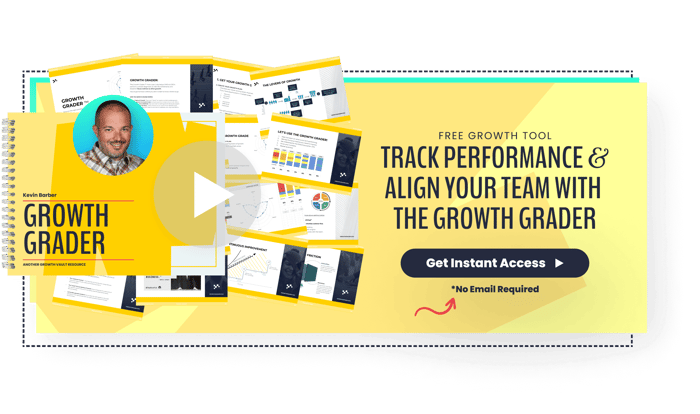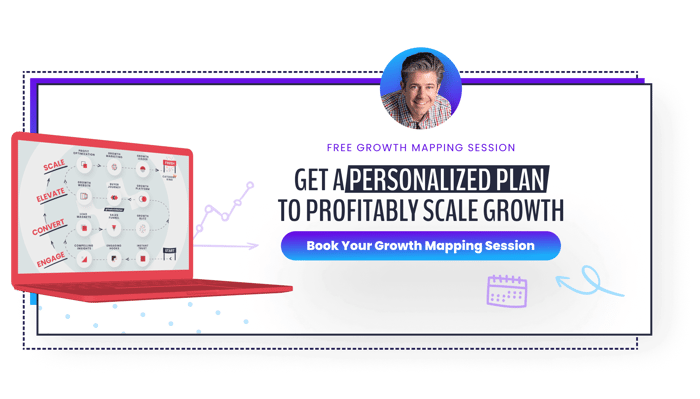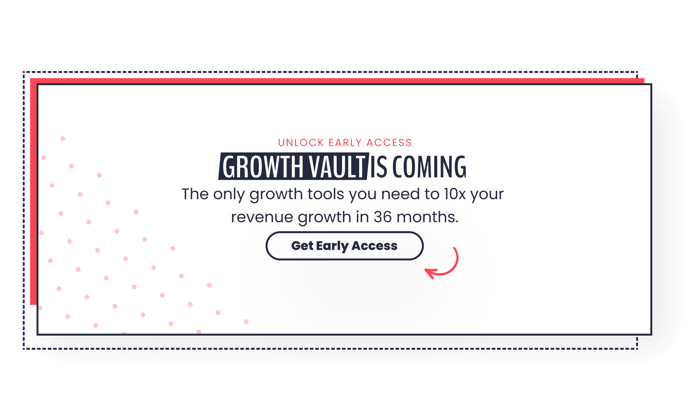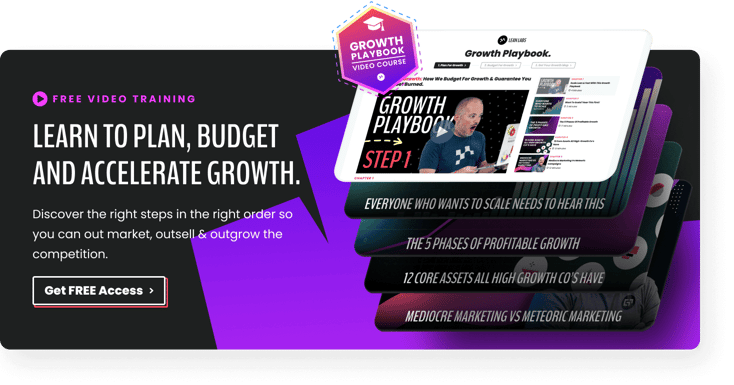Driving business growth is the ultimate goal for many business owners and marketing professionals. But it’s easier said than done. Are you missing the key to driving long-term, quarter-over-quarter growth?
If you feel like you’ve been scratching and clawing at your growth ceiling for months, quarters, or even years, you need to try something new. You need a new formula for unlocking massive growth. You’re in luck—we’ve got a recipe for growth that has been tried and tested by businesses across industries.
Focusing on all six levers of growth ensures that your business commits to not only gaining the attention of potential customers or even winning their business. Instead, you commit to providing incredible value to potential customers and existing clients at every stage in their journey. As a result, you’ll see greater customer retention, higher customer lifetime value, and increased referrals and testimonials.
Let’s cover all six levers of growth marketing, starting with the end of the traditional “funnel” and working our way back up to the top.
1. Reputation
The reputation growth lever improves the way your brand is perceived in the marketplace. This includes the amount of referral business you get, how well your products are rated and reviewed online, and how many compelling case studies and testimonials users can find about your business and products.
You must have a system in place to drive referral business. If you’re actually serving your customers and providing value, they will want to share you with their colleagues and friends.
The problem is, most customers don’t know how, or it never comes to mind. That’s why you need a referral system in place to give them the tools they need to share with their circle of influence, and the prompts to bring it to mind.
Related Read: 5 Creative B2B SaaS Lead Generation Strategies to Test
As Simon Sinek says, "start with why."
Why do they stay with you?
Is it because of long-term contracts? Maybe not the best reason.
Is it because you’re making their lives better? Then, make your referral pitch about that.
What is it that they love you for? Ask them to share that message with their circle and on 3rd party review sites like G2 and Trust Pilot.. You can even give them the prompts and tools they need to make that happen.
2. Retention
The retention growth lever measures how well you retain, cross-sell, and up-sell existing customers.
When someone purchases a new product or tool for the first time, rarely is that a one-and-done forever kind of situation. As Russell Brunson says, “if you don’t have recurring revenue, you don’t have a business.”
Diving into the Sinek point again, why are your customers sticking with you?
In some rare cases, it’s because they don’t have a choice. I’m looking at you AT&T and Comcast.
If they had a choice, they would be gone. If this is the case, you have bigger problems than growth.
In other rare cases, it’s because of habit. Some people buy Wonder bread because they always have. It’s the package they look for, they grab it while in the store, and never really think about it.
In most cases today, customer retention happens because of the experience and value the product or service provides.
So, let me ask you again, why are your customers staying with you?
Whatever reason, this needs to become your message to your prospective customers. It’s not important to communicate only why they should buy from you, but you must communicate why they will stay with you.
If you want to grow, make sure your customer experience isn’t a ‘come in and pay at the front door, walk right out the back door’ experience. If that’s the case, you will always be struggling to grow.
If you can close and lock the back door, all the new ones coming through the front are growth.
That’s a bad analogy because locking customers in is never a good experience. And as soon as something comes along to spring them free, they are gone. You’re playing with fire, there.
It’s much better if they stay because they want to. If you can make that happen, you have yourself a good recipe for hyper-growth.
3. Revenue
This is the growth lever people get the most excited about. It’s that moment when the prospect pulls out their credit card and says yes to the sale. Having this lever of growth working at full potential is key to high growth rates.
How do you make sure this lever works at its full potential?
Well, that’s the mystery most companies are trying to solve. They either have too many unqualified leads, and revenue suffers, or they have too few leads and revenue suffers. We’ll talk about this in the next section, but getting the revenue piece right is hard.
Related Read: 6 Growth Marketing Metrics Every Business Needs
The good news is, it’s figure-outable.
This lever must connect and be driven by the levers that come after it. Explore what drives your retention and referral, and you’ll have a good idea of the message that will resonate with your prospects.
At the same time, this lever must be inseparable from the levers that come before it, too.
Marketing needs a seat and a stake at the sales table. It’s the only way they will ever see eye to eye with sales. Only when you get them on the same team striving for the same KPI will you get them working together. Otherwise, you get silos.
Marketing pats themselves on the back over vanity metrics. Sales throws all blame and responsibility for close rates on the poor leads marketing provides. Marketing throws all blame on the salespeople not being able to close enough leads.
Back and forth it goes.
But, what if marketing was responsible for getting sales-ready leads into the hands of the salespeople at a high enough rate that they hit their number? What if marketing sat in on sales calls, and fielded customer support questions?
This leads us to the next lever, which is a marketing one:
4. Activation
The activation lever is about “activating” leads into the sales process. Gathering leads in a database does nothing if they don’t raise their hand to talk to sales.
Activation measures the rate at which marketing qualified leads(MQLs) ascend into a sales meeting. Activation is typically accomplished through targeted lead nurturing.
This is where the magic happens, although it’s not what excites most marketers. So, you need to make sure they are on board. If they have a stake at the revenue table, they will get excited about this metric.
Activation is about pre-conditioning contacts to make the decision to buy before they talk with anyone in sales. In today’s world, consumers do their research. They are only going to jump on a call with someone, as a general rule, after they know all the details.
They will do their research somewhere, it might as well be on your website.
Check that, it should be on your website. That’s the only time you can do great marketing.
You see, marketing isn’t about broadcasting messages. Building advertisements isn’t marketing. Producing a blog post or sharing something on social media isn’t really doing marketing.
You can do all that stuff and do zero marketing.
What kind of crazy am I talking about?
Marketing is one thing: changing beliefs with the intent of making a sale. (Thank’s Russell)
If your ad, blog post, video, podcast… and so on - if those are not working to change the beliefs of your audience, you’re not doing great marketing.
Great marketing is not just promoting a product, it’s convincing the audience that the product is the right one, the one they want, and the one that will meet their needs.
This doesn’t mean marketing is nefarious. This only works if it’s legitimate and genuine.
For example: have you ever talked to an Apple fan about which computer you should buy - PC or Mac?
We all know both are amazing machines.
Why are they so passionate about changing your beliefs into believing that Mac is the best?
What has Apple done to instill that kind of belief into their customers?
You’re starting to see the magic, aren’t you?
Email nurturing is not just about keeping your brand name in front of your prospects or sharing your monthly special. Well, in too many cases, that’s all it is to brands.
But it should be about instilling that kind of belief in your product.
In the previous section, we talked about how the Revenue lever is inseparable from the levers before it and after it. How high do you think the closing rate will be for sales if 80% of the contacts they talked to were already decided?
What kind of closing rate will a salesperson have when the contact is calling to say, “take my money!”?
If activation is done right, that will be the experience more often than having to overcome objection after objection.
5. Acquisition
The acquisition growth lever measures how effectively you generate leads, typically in the form of names, email addresses, and/or phone numbers.
This lever should also live inseparably from the lever before and after it.
It does no good to grow lead generation by 100% month over month if the majority of the leads were never going to buy. Yet, a lot of marketing teams (and agencies) celebrate their lead generation numbers and ignore the fact that few of them are becoming opportunities.
You must ask yourself:
- Do the leads we’re generating match our ideal customer persona?
- Do these leads have decision power?
- Are the leads we’re generating reliably ascending into the sales pipeline and becoming customers?
If the answer to any of these questions is no, then you are likely wasting time and money generating those leads. Instead, focus your attention on tactics and channels that drive high-qualify, sales-ready leads.
It’s okay if that means you don’t actually convert unqualified leads. Sure, the overall number of leads (vanity metric) will be lower. But the growth impact will be higher.
Related: Hiring A B2B Lead Generation Agency: 8 Pros And Cons
6. Awareness
The awareness growth lever is a measure of how many people are aware of and engaging with your brand. This may be measured by website visitors, social media followers, or marketplace visibility.
This is the fun one!
This is where you get to publish and get all kinds of traffic!
But hold up a minute...
- What kind of traffic are you trying to generate?
- What are you publishing about?
- What are your podcast episodes about?
- What are your social media posts about?
Do they connect with all the other levers above? If not, your conversion rate is going to be really low.
Whatever awareness you build, it needs to be with the people who will buy, stay with, and promote your brand.
Again, it does no good to get two million page views a month if none of them are interested in buying your product or service.
Traffic is a vanity metric if it’s not intricately connected to all the other levers.
Sure, marketing won’t get excited when their dreams of 2,000,000 page views gets demoted to 10,000… but if that 10,000 are the perfect matches, the other 1,990,000 mismatched website visitors don’t really matter.
Using Growth Levers to Maximize Your Growth
It’s time to rethink all of your success metrics. Are the KPIs able to be great without growth? If so, it’s a vanity metric and should be abandoned or tweaked.
At the end of the day, the only thing that matters is growth. You need your sales, marketing, and product teams to come together, focus on all six levers of growth, and drive success for your business.
Embrace growth-driven design, create customer-centric marketing content, and focus on nurturing and providing value to your potential and existing customers at every stage of their journey and you’ll start off on the right foot.
But this is only the beginning.
To maximize your business’s growth, you need a playbook for success. Check out our free resource, the Growth Playbook, today to learn how to plan for growth, reliably scale revenue, and understand where you are today and how to get where you want to go.








